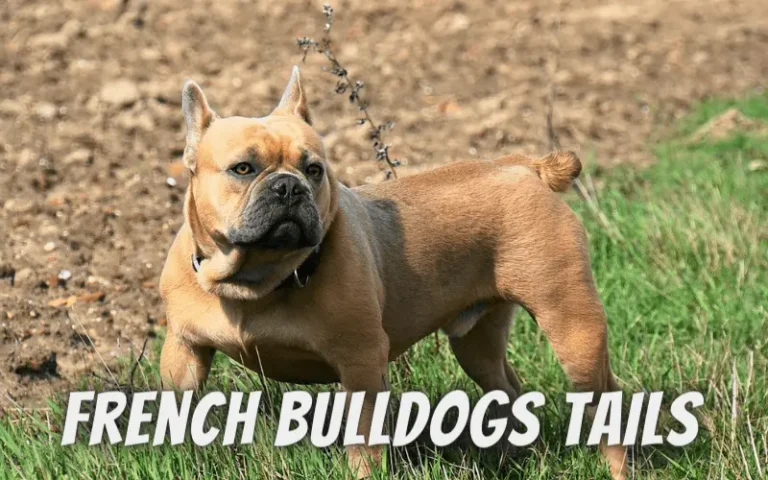French Bulldogs With Long Tails
French Bulldogs, known for their charming personalities and distinctive bat-like ears, have become incredibly popular as companion dogs worldwide.

Among the various traits that set them apart, one fascinating feature that sparks curiosity among dog enthusiasts is their tails. Unlike most breeds, some French Bulldogs are born with longer tails, which adds to their uniqueness.
In this article, we will delve into the intriguing topic of French Bulldogs with long tails, exploring the reasons behind this trait, its implications for the breed, and whether it affects their overall health and well-being.
The Origin of the French Bulldog Tail
To understand why some French Bulldogs have long tails, it’s essential to explore the breed’s history. French Bulldogs were popular with lace workers in Nottingham in the 1800s, who imported them to France during the Industrial Revolution. In France, they quickly gained popularity among various social classes, eventually earning the name “French Bulldog.”
During this period, the breed was selectively bred to accentuate certain characteristics, including their bat-like ears and short, compact bodies. However, variations in tail length also emerged, leading to the existence of French Bulldogs with long tails.
Is it true that French Bulldogs have Tails?
French Bulldogs, yes, they have tails. However, their tails are naturally short and unique in appearance. Unlike many other dog breeds with long and wagging tails, French Bulldogs have a characteristic short and often screw-like or corkscrew-shaped seat.
This distinguishing characteristic is one of the many reasons why French Bulldogs are liked by dog lovers all over the world and remain popular as valued companion animals.
A French Bulldog’s short tail is a distinctive feature of the breed and is present from birth. It is not docked or shortened through any surgical procedure; rather, it is a natural feature that distinguishes them from other breeds.
The tail of a French Bulldog is set low and is usually carried low or slightly curved upwards. When they are excited or happy, they may wag their short tails in a circular or side-to-side motion, adding to their endearing charm.
The short tail of a French Bulldog serves a functional purpose, especially given its brachycephalic (short-faced) structure. A long tail could be more susceptible to injuries or accidental damage, so the compact and twisted shape of their tail is advantageous for their overall well-being.

Do French Bulldogs have their Tails docked?
No, French Bulldogs do not have their tails docked as a standard practice. Tail docking involves the surgical removal of a portion of a dog’s tail, and it is commonly done in some breeds for various reasons, such as historical working purposes or to conform to breed standards.
However, tail docking is not considered necessary or common in French Bulldogs. The breed’s tail is naturally short, and most French Bulldogs are born with short tails or “screw” tails, which are naturally curled. Docking a French Bulldog’s tail is generally not recommended or endorsed by reputable breed organizations and veterinarians.
It is essential to remember that tail docking, when not medically necessary, is considered a controversial and debated practice. In many countries and regions, tail docking is even prohibited unless there is a valid medical reason, as it is viewed as unnecessary and potentially harmful to the dog’s well-being.
As responsible pet owners, it is essential to prioritize the health and welfare of our canine companions and respect breed standards that do not require or promote tail docking in French Bulldogs or other breeds.
French Bulldog Screw Tail
The French Bulldog Screw Tail is one of the distinctive features that sets this breed apart. Instead of a long, straight tail like many other dog breeds, French Bulldogs have a short, twisted tail that resembles a corkscrew or a screw.
Along with their charming personalities and affectionate nature, the screw tail adds to the allure of French Bulldogs and continues to captivate dog enthusiasts worldwide.
As the puppy grows in the womb, the tail starts to twist and curl, resulting in the screw tail formation.
This distinctive feature is present from birth and remains a defining characteristic of the breed throughout their lives. The appearance of the screw tail can vary among individual French Bulldogs.
Some may have tightly coiled tails, while others may have looser or more pronounced twists. Regardless of the specific appearance, the screw tail is a defining trait that contributes to the overall adorable and unique look of the French Bulldog.
Aside from being a visually appealing feature, the screw tail also serves a functional purpose. The compact, screw tail is less prone to injury and helps prevent accidental damage to the tail, especially in tight spaces or during physical activities. As with any breed trait, it is essential to consider the overall health and well-being of French Bulldogs with screw tails.
French Bulldog CorkScrew Tail
The term “French Bulldog corkscrew tail” refers to the same unique tail characteristic that was previously described as the “screw tail.” The corkscrew tail is a defining feature of the French Bulldog breed, whose short tails are tightly twisted, resembling the shape of a corkscrew or spiral.
Along with their friendly personalities and lovable nature, the corkscrew tail is a defining characteristic that continues to make French Bulldogs a beloved and sought-after breed. As mentioned earlier, the corkscrew tail is a natural trait in French Bulldogs and is caused by a genetic mutation that affects the development of the tail vertebrae.
This distinctive tail appearance is present from birth and remains throughout the dog’s life. Just like the screw tail, the corkscrew tail also serves a functional purpose. It is less prone to injury and damage due to its compact and twisted shape, which is particularly advantageous for a brachycephalic breed like the French Bulldog.
Brachycephalic breeds have short, flat faces, and a long, straight tail could be more susceptible to accidental injuries. The corkscrew tail is one characteristic that contributes to the French Bulldog’s overall adorable and unique appearance. This breed’s popularity has been steadily growing worldwide, and its distinctive physical features, including the corkscrew tail, play a significant role in captivating the hearts of dog enthusiasts.
As with any breed trait, it is critical to focus on the entire health and well-being of French Bulldogs, especially those with corkscrew tails. Responsible breeding procedures and frequent veterinary care are required to ensure that these dogs enjoy happy and healthy lives.
Addressing Health and Ethical Concerns
One of the main concerns associated with long-tailed French Bulldogs is the potential impact on their health and well-being. As mentioned earlier, the corkscrew tail is a natural trait in French Bulldogs and is caused by a genetic mutation that affects the development of the tail vertebrae. This distinctive tail appearance is present from birth and remains throughout the dog’s life.
Just like the screw tail, the corkscrew tail also serves a functional purpose. It is less prone to injury and damage due to its compact and twisted shape, which is particularly advantageous for a brachycephalic breed like the French Bulldog. Brachycephalic species have short, flat faces, and a long, straight tail could be more susceptible to accidental injuries.
The corkscrew tail is one characteristic that contributes to the French Bulldog’s overall adorable and unique appearance. This breed’s popularity has been steadily growing worldwide, and its distinctive physical features, including the corkscrew tail, play a significant role in captivating the hearts of dog enthusiasts.
As with any breed trait, it is crucial to prioritize the overall health and well-being of French Bulldogs, including those with corkscrew tails. Responsible breeding practices and regular veterinary care are essential to ensure that these dogs lead happy and healthy lives.
Genetics and Tail Length
The length of a French Bulldog’s tail is primarily determined by genetics. Long-tailed French Bulldogs inherit the trait from their parents, who possess a specific combination of genes responsible for tail length. These genes are passed down through generations, leading to some puppies being born with longer tails. While it is relatively uncommon, the presence of long-tailed French Bulldogs continues to pique the interest of breeders and enthusiasts alike.
The Impact on Breed Standards
Breed standards play a crucial role in dog shows and breeding practices. The official breed standard for French Bulldogs, as defined by kennel clubs and breed organizations, typically specifies the ideal tail length.
However, with the emergence of long-tailed French Bulldogs, there has been an ongoing debate within the community about whether this trait should be accepted and incorporated into the official breed standard. Some argue that embracing this natural variation could promote diversity within the breed, while others remain devoted to the traditional short-tailed appearance.
Understanding the Popularity
Despite the ongoing discussions surrounding tail length, French Bulldogs with long tails have captured the hearts of many dog lovers. Their unusual features and swaying tails set them apart from the throng. As social media platforms continue to showcase these adorable canines, their popularity has only grown, with enthusiasts actively seeking breeders who specialize in producing long-tailed French Bulldogs.
Frequently Asked Questions
Are long-tailed French Bulldogs rare?
Long-tailed French Bulldogs are relatively rare but gaining attention within the dog-loving community.
Can the tail length be altered through breeding?
Breeding practices may influence tail length, but genetics play a significant role in determining the trait.
Are long-tailed French Bulldogs require any special care?
Long-tailed French Bulldogs require the same care as their short-tailed counterparts, including regular exercise and grooming.
Are French Bulldogs having long tails more prone to tail injuries?
While there is no concrete evidence, it’s essential to handle all dogs with care to prevent any potential injuries.
Where can I locate a trustworthy long-tailed French Bulldog breeder?
Before making a purchase, look into reputable breeders who value the health and well-being of their dogs and meet them in person.
Conclusion
The presence of French bulldogs with long tails adds a fascinating twist to the breed’s already intriguing history. Whether or not this trait becomes widely accepted in the official breed standard, these charming canines continue to capture hearts and spread joy wherever they go. Remember, regardless of tail length, the health and happiness of the French Bulldog should always remain the top priority for breeders, owners, and enthusiasts.







